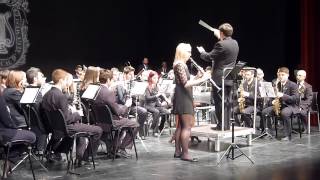July 31st is the day of St. Ignatius
Recommended music videos for initiation to classical music
Ignatius of Loyola (1491-1556) was a Basque military man and later religious leader, who emerged as a religious leader during the Counter-Reformation ; his devotion to the Catholic Church was characterized by absolute obedience to the Pope . Founder of the Society of Jesus, he was at the head of the same for fifteen years, remaining in Rome . His Spiritual Exercises , published in 1548, exerted a proverbial influence on subsequent spirituality. The Methodist Jesse Lyman Hurlbut considered Ignatius of Loyola as one of the most notable and influential personalities of the 16th century . Pope Gregory XV canonized him on March 12, 1622. He died on July 31, 1556 and his body, which was initially buried in the church of Santa Maria della Strada , was transferred to the Church of the Gesù , headquarters of the Society .
Nemesio Otaño y Eguino (1880–1956) was a Jesuit composer and musicologist. At the age of 6 he began studying music theory, at 8 piano and at 11 organ. In 1896 he joined the Society of Jesus and was soon appointed organist of the Basilica of Loyola . In 1907 he organized the First National Congress of Sacred Music in Valladolid ; that same year he founded Música Sacra Hispana , a magazine which he directed until 1922; he also created and directed the famous Schola Cantorum of the Pontifical University of Comillas and between 1940 and 1951 he directed the Conservatory of Madrid . Throughout his life Otaño wrote abundant works of popular and religious inspiration. In 1941 he was named Knight of the Order of Alfonso X the Wise and in 1943 he entered the Academy of Fine Arts of San Fernando .
The March of San Ignacio was written by Nemesio Otaño for the celebration of the first centenary of the Reestablishment of the Society of Jesus . The version we present today is offered by the Orfeón Donostiarra, the Choir and Choir of San Ignacio of San Sebastián, the Eskifaia Choir of Fuenterrabía, the Choirs of Azpeitia and Azkoitia , the organist and concert pianist José Manuel Azkue and the Euskadi Symphony Orchestra , all conducted by Maestro Enrique Ugarte .
Franz Schubert (1797-1828) was an Austrian composer who, at the age of 11, was admitted as a member of the choir of the Imperial Chapel in Vienna , where he was taught by Salieri . At that time, the only profitable production was theater and opera, a genre in which he never managed to excel; so he turned to other genres, especially lieder (songs), among which his Ave Maria stands out. and the lieder ensemble La Bella Molinera . Despite dying at the age of 31, he left behind over 1,500 works, including numerous piano and chamber music pieces, eight symphonies, concertante works, incidental music, sacred music (including seven Masses, one Oratorio, and one Requiem), several singspiels (short operettas), some opera, and over 600 short vocal works, primarily the aforementioned lieder.
Ständchen (known in English by its first line "Hark, hark, the lark"), D 889 , is a lied (song) for solo voice and piano by Franz Schubert , composed in July 1826 in the village of Währing (now a suburb of Vienna). It is a setting of the "Song" from Act 2, Scene 3 of Shakespeare 's Cymbeline. The song was first published by Anton Diabelli in 1830, two years after the composer's death. The song in its original form is relatively short, so two more verses by Friedrich Reil were added to Diabelli's second edition of 1832.
Today we offer it in a cello and piano version with Camille Thomas on cello and Beatrice Berrut on piano.
John Williams (1932) is an American composer, conductor, pianist and trombonist, considered one of the most prolific composers of soundtracks in the history of cinema; he has composed some of the most famous and recognizable of all time such as: Star Wars, Harry Potter, Jaws, Catch Me If You Can, ET, Superman, Indiana Jones, Jurassic Park, Schindler's List, Home Alone and others. He has also composed musical compositions for various Olympic Games , numerous television series, newsreels and several Concert Works . He has won the Oscar five times and has 52 nominations to his credit, making him the second man with the most nominations for the highest award in the seventh art after Walt Disney .
John Williams & Steven Spielberg Orchestra Live
00:00:00 Anything Goes / Indiana Jones and the Temple of Doom 00:04:10 Jaws 00:10:30 1941 00:15:10 Close Encounters of the Third Kind 00:21:50 ET the Extra-Terrestrial 00:26:00 Hook 00:31:10 Munich 00:35:40 Catch Me If You Can 00:38:55 Raiders of the Lost Ark 00:44:05 Indiana Jones and the Temple of Doom 00:49:40 Lincoln 00:55:35 The Terminal 01:00:15 Horse War 01:06:45 Schindler's List 01:11:50 The Lost World: Jurassic Park 01:15:40 Indiana Jones and the Crystal Skull / The Adventures of Mutt 01:19:20 Raiders of the Lost Ark / Marion's Theme 01:23:05 Indiana Jones and the Crystal Skull / Call of the Crystal 01:27:20 Indiana Jones and the Last Crusade 01:32:55 Jurassic Park 01:39:20 Star Wars: Episode VII The Force Awakens / Rey's Theme
Pascual Pérez Choví was born in Carlet , Valencia Province (Spain) on February 26, 1889 and died in Alginet (Valencia) on December 3, 1953. He began his musical studies at the age of 7, taking solfeggio and clarinet lessons from Professor Aguado , director of the Municipal Band of Valencia . At the age of 11 he began to play in this Band, first playing the clarinet in E flat and then in B flat . He continued his studies in 1920 with Maestro Navarro , director of the military chapel in Valencia , and later went on to direct some bands such as the Band of Music " Sociedad Artística Musical de Alginet " in 1923. This Band won two second prizes when returning to the " International Competition of Music Bands of the City of Valencia ", in 1924 and 1925. In 1926 he premiered the pasodoble " Pepita Greus " in this Competition, obtaining first prize. In 1930 they again won first prize in Valencia , another first prize in the " Certamen de Requena " (Valencia) and a second prize in the " Certamen de Benifayó " (Benifayó Competition), Valencia .
The mazurka was originally a ballroom dance of the Polish royal court and nobility, which eventually evolved into a dance of the lower class. Written in triple time (3/4, 3/8), it is characterized by its accents on the 2nd and 3rd beats, in contrast to the waltz . It became popular throughout Europe along with the polka (of similar structure) during the second half of the 19th century and became the fashionable dance of major European capitals during that century. It is danced in pairs and is a lively and graceful dance.
Today we offer the mazurka A ti, written by Pascual Pérez Choví for clarinet and marching band and performed by the young clarinetist Kimberly Borràs accompanied by the Algemesí Symphonic Band conducted by maestro Alberto Ferrer i Martínez .
Recommended classical music videos
Domenico Zipoli (1688–1726) was an Italian-Latin composer of the Baroque period , considered the most famous European composer to have traveled to the Americas during the colonial period. From 1707 he studied in Florence , Naples, Bologna and Rome where he held various positions, the most important of which was organist of the Chiesa del Gesú . During the first months of 1716, Zipoli traveled to Seville, where he began his novitiate, entering the Jesuit Province of Paraguay on July 1. The following year he settled in Córdoba , Argentina , where he completed his studies in philosophy and theology. He died in 1726 due to an infectious disease, probably tuberculosis, after writing abundant religious works and the opera that we present today.
Saint Ignatius of Loyola is an opera in two acts with an eminently pedagogical libretto aimed at evangelization. The main characters are Saint Ignatius of Loyola, Saint Francis Xavier , and the Devil who unsuccessfully tempts the two saints. As this work was written to be performed in missions, usually by children, it is written for a treble voice range. (Excerpt from the magazine Scherzo) .
The version we offer today is conducted by maestro Gabriel Garrido .
Nicolai Rimsky-Korsakov (1844-1908) was a Russian composer who belonged to the Five (a group composed of Balakirev, Borodin, Cui, Musorgsky and Rimsky-Korsakov himself) who set themselves the common goal of promoting Russian music, moving away from European musical dependence and favoring musical nationalism. Rimsky 's works are considered to be examples of varied, colorful and balanced orchestration and are considered among the most representative of the orchestral repertoire; all within his nationalist creed that promoted the incorporation of motifs, rhythms and songs from Russian folklore into his creations.
The Great Russian Easter Overture, Op. 36 , subtitled " Overture on Liturgical Themes ", is a concert overture composed by Rimsky-Korsakov between August 1887 and April 1888, dedicated to the memory of Modest Mussorgsky and Alexander Borodin , two members of the Five ; its premiere took place in St. Petersburg at the end of December 1888. It is the last of three exceptionally brilliant pieces for orchestra, preceded by the Caprice Espagnol and Scheherazade . The melodies of this overture are mostly taken from the liturgy of the Russian Orthodox Church , based on an ancient collection of chants called Obikhod . Today it is offered to us by the Simón Bolívar Youth Symphony Orchestra conducted by the young Venezuelan maestro Rafael Payare .
Francis Poulenc (1899 – 1963) was a French composer and member of Les Six , a group comprising Milhaud, Auric, Durey, Honegger, Tailleferre (the only woman in the group), and Poulenc himself. He embraced the techniques of the Dada movement (anti-artistic, anti-literary, and anti-poetic movement that questions the existence of art, literature, and poetry). Critic Claude Rostand describes Poulenc as "half heretic, half monk", a label that remained attached to his name for the rest of his career, while Poulenc says: "My work is the juxtaposition of the profane with the sacred." Some critics consider him the first openly gay composer in history. He composed music in all the major genres, including chamber music, oratorio, opera, ballet, and orchestral music.
Gloria is a musical composition by Francis Poulenc, one of his most celebrated works, written between May and December 1959. The work was written for soprano soloist, large orchestra and chorus . It was commissioned by the Koussevitzki Foundation in honor of the recently deceased Natalie and Sergei Koussevitzky and premiered in January 1961 in Boston . The work is organized in six movements: I (0´02´´) GLORIA IN EXCELSIS .-. II (2´45´´) LAUDAMUS TE .-. III (6´03´´) DOMINE DEUS .-. IV (10´56´´) DOMINE FILI UNIGENITE .-. V (12´28´´) DOMINE DEUS, AGNUS DEI .-. VI (19´06´´) QUI SEDES AD DEXTERAM PATRIS
The version we present today corresponds to the concert that was offered, on the occasion of the centenary of the Warsaw University Choir , at the Church of All Saints in Warsaw on December 3, 2022 with the soprano Dorota Szczepanska and the Warsaw University Choir accompanied by the Płock Symphony Orchestra, Witold Lutosławski , all conducted by maestro Irina Bogdanovich .
Keiko Abe (April 18, 1937, Tokyo, Japan) is a Japanese composer and marimbist. She studied xylophone with Eiichi Asabuki in Tokyo and attended Tokyo Gakugei University where she completed her bachelor's and master's degrees in music education . Her first exposure to the marimba took place in the early 1950s when Lawrence L. Lacour , a professor and missionary living in Japan , introduced the instrument to the university where he taught. "One day I was going to the morning ceremony when I saw the marimbas and heard the hymns being played. I was so captivated by the sound that I forgot where my seat was! It was a different sound, very deep, especially the low tones, and it made a strong impression on me." Keiko Abe (Percussive Arts Society, 1993)
Although he began as part of a group that played pop music , The Xebec Trio , in 1962 he joined the Tokyo Marimba Group with whom he began to perform compositions by contemporary authors, progressively expanding the limited repertoire that the instrument then had. In fact, several of his compositions such as "Michi", "Variations on Japanese Children's Songs" and "Dream of the Cherry Blossoms" have become standards in the marimba repertoire. Abe has contributed nearly 70 compositions to the marimba repertoire and uses improvisation as an important element in the development of musical ideas. Keiko Abe was the first woman to be inducted into the Percussive Arts Society Hall of Fame in 1993.
Today we offer her Concerto for Marimba and Wind Band , The Wave Impressions, with Maestro Abe as marimba soloist accompanied by the young and excellent St. Ursula Eichi High School Wind Orchestra conducted by Maestro Masaki Endoh.
Recommended music videos for all tastes
Coleman Hawkins (1904-1969) was an American jazz clarinetist and, above all, tenor saxophonist whose performances always remained within the purest classical style. At a time when the saxophone was an unusual instrument and considered to have a lesser status, Hawkins brought it recognition in the jazz world. At the age of twelve, he was already performing professionally on the tenor saxophone; at 19, he moved to New York , where he accompanied various blues singers and was a member of various orchestras. He spent five years in Europe as a principal guest of jazz ensembles, and upon his return to the USA , he founded his own orchestra, despite which he continued to perform with the most renowned musicians of the genre.
Krisdayanti (born 1975) is a popular Indonesian singer and actress. Her singing career began when she was a child; she began to devote herself to music at just nine years old and at 12 she was recognized as one of the youngest pop artists in her country. In addition to being one of the most successful icons in the Indonesian music industry, she has received several awards, both at home and abroad. She was named one of the "10 Greatest Asian Artists" by Channel V in 2005. She is also one of the "99 Most Powerful Women in Indonesia " in the October 2007 issue of Globe Asia magazine and "The 50 Greatest Indonesian Singers of All Time" in the December 2010 issue of Rolling Stone .
Itoiz was a Basque rock band created in 1976 and disbanded in 1988. Itoiz composed and sang their songs in Basque. The origin of Itoiz lies in the group Indar Trabes , formed in 1974 by five young people from the surrounding areas of Mutriku and Ondarroa who were fans of progressive rock . In order to finance the purchase of instruments, they began livening up weddings and festivals, which earned them a certain notoriety in their environment. When in 1978 they had the opportunity to release their first album, they decided they needed another name to differentiate it from their commercial activity, so they adopted the name Itoiz . Two stages can be distinguished in their history; in the first, sounds close to progressive rock, jazz and experimental music predominate. In the second, after the entry of guitarist Jean-Marie Ecay into the group in 1983, their style drifted towards pop rock . Itoiz 's leader and founder was Juan Carlos Pérez , who wrote songs such as "Lau teilatu ." The group disbanded in 1988, after recording a live album at the Fadura sports center in the Biscayan town of Getxo.
Ezekiel is the second album by the Basque group Itoiz , released in 1980. The group Itoiz had ceased to exist with the release of their first album. Its leader, Juan Carlos Pérez , began working on songs for another album that he planned to release under his own name. However, his record company convinced him to go back to using the name Itoiz , which had become quite well-known in the Basque Country as a result of the success of their previous album. In Pérez 's words, the album is "the story of young Ezekiel , who encounters the problems of generational change; he tries to fight against the world that oppresses him, uses violence and encounters decadence. For this reason, the music is also decadent." Musically, it has a much jazzier style than the previous one. The electric guitars have almost disappeared, being replaced by acoustic ones, and it also features several songs sung by female or children's voices instead of Juan Carlos Pérez .
Adele (London, 1988) is a British singer-songwriter and one of the world's best-selling musical artists, with over 120 million sales between albums and singles. The release of each of her albums has set significant sales records around the world; for its sales it has been certified seventeen times platinum in the United Kingdom , while in the USA it obtained the diamond certification and has several mentions in the Guinness World Records; she was also decorated as a Member of the Order of the British Empire by Prince Charles . Throughout her career, she has been awarded a total of fifteen Grammys , twelve Brit Awards , an Oscar and a Golden Globe , among others. In 2020, her album 21 has been included in Rolling Stone ' s list of the 500 greatest albums of all time .
Recommended peculiar videos
Léo Delibes (1836 -1891) was a French Romantic composer. His mother was a musician and his grandfather an opera singer. His nephew Frédéric was the paternal grandfather of the Spanish writer Miguel Delibes . He began his musical studies at the Paris Conservatoire in 1847, where he was a student of Adolphe Adam . As a composer, he achieved real fame in 1870 with the success of his ballet Coppélia ; among his other ballets, Sylvia , written jointly with Léon Minkus , is also worth mentioning; the Pizzicato from this ballet is very popular, one of Delibes ' greatest hits. He also composed several operas and operettas, a mass, a cantata, and occasional music for the theatre, such as dances and ancient airs.
Sylvia , originally Sylvia ou La Nymphe de Diane (“Sylvia or the Nymph of Diana”) is a ballet in three acts, choreographed by Louis Mérante and with music by Léo Delibes , premiered on 14 June 1876 in Paris . Sylvia is a remarkable classical ballet, with peculiarities that make it unique due to its mythological setting of Arcadia , its creative choreography, its extensive scenery, its great influence on the arts and, above all, its remarkable score. When Sylvia premiered on 14 June 1876 at the Palais Garnier , it was widely ignored; it was with its revival in 1952, with new choreography by Sir Frederick Ashton , that it became popular.
Pas de deux (in English, Step a deux ) . In ballet, a pas de deux, also known as a grand pas de deux , is a move performed jointly by two people. It usually consists of an entrée (entrance of the couple), adagio, two variations (one for each dancer, usually an allegro), and a coda . Heir to the ballet entrée , the pas de deux appeared in the mid- 18th century in action ballet and was fully developed in the 19th century in Romantic ballet. It symbolizes the love of a couple and illustrates the most poetic moments of ballet. Contemporary choreographers prefer to speak of a "duet" rather than a pas de deux .
Today, choreographed by George Balanchine , we offer the Pas de deux from the Ballet Sylvia with Martine van Hamel and Patrick Bissel .
Gerónimo Giménez (Seville, 1854 – Madrid, 1923) was a Spanish composer and conductor, who dedicated himself primarily to the composition of zarzuelas, leaving behind notable titles such as La tempranica and La boda de Luis Alonso . He began his musical studies with his father and later continued in Cádiz with Salvador Viniegra . He was a child prodigy, who at the age of 12 entered the Teatro Principal in Cádiz as first violin. By the age of 17, he was already director of an opera and zarzuela company and was awarded a scholarship to study violin and composition in Paris . In 1885, he was appointed director of the Teatro Apolo in Madrid ; shortly afterwards, director of the Teatro de la Zarzuela and later, director of the Sociedad de Conciertos , a position he held for 12 years. He died in Madrid on 19 February 1923.
Today the José Racero Ballet offers us a carefully choreographed performance of the Prelude from the one-act zarzuela La Torre del Oro by maestro Gerónimo Giménez .
The Amalia Hernández Ballet , based at the Palacio de las Bellas Artes in Mexico City and also known as the Ballet Folklórico de México , was founded in 1952 by dancer and choreographer Amalia Hernández . It has created more than 60 of its own choreographies and has performed throughout Mexico. It also has toured more than 100 times internationally, visiting a total of 60 countries. Over the past few years, it has been a benchmark for traditional Mexican music and dance.
Today we offer the second part of the choreographic painting " The Revolution " performed by the Ballet Folklórico de México of Amalia Hernández accompanied by the Youth Symphony Orchestra of the State of Veracruz (Antonio Tornero, director) within the 60th Anniversary Gala at the National Auditorium in Mexico City , January 13, 2013. ( Excerpt from the video footer )
The Mayib' K'Astajib'al Cultural Group of Guatemala is a group made up of young people from Santo Tomás Chichicastenango who, through dance, promote the culture of their people, emphasizing the promotion and dissemination of cultural artistic manifestations throughout the Guatemalan nation, thus highlighting our customs and traditions.
The dance presented today is called " Saq Po't Chu Nin Pol " (Güipil with a white background), where one of the ancient costumes of the Chichicasteca women is revealed, as well as the place of the presentation held in Chupo I, one of the largest areas of the municipality and in the viewpoint of the community of Chuguexá II where you can see Lake Atitlán . (Extracted from the text at the bottom of the video)
Recommended music videos for children
Various Wikipedia articles have been used to write these texts.
The texts of Videomusicalis are written in Basque, Spanish and English.



























